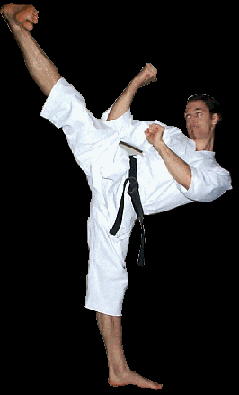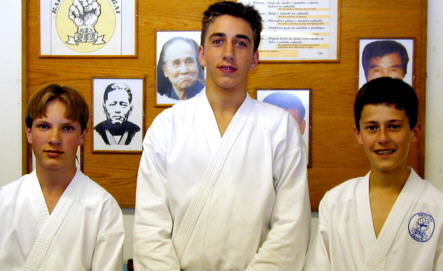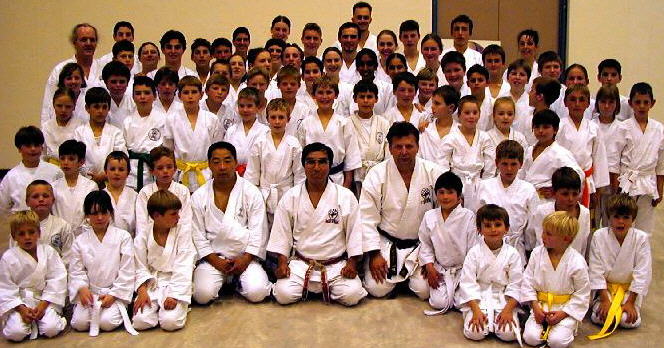

Goju-Ryu at the Hare-Yama Dojo
Japanese karate-do masters recognise the line of their teachers as the authentication of their karate-do knowledge. For this reason, we like to acknowledge the line of teachers that contributed to the Goju-Ryu Karate-do that is taught at the Hare-Yama Dojo. While Higashionna Sensei and Miyagi Sensei were instrumental in developing Goju-Ryu, clearly Grand Master Gogen Yamaguchi is the key person in this line for us. When he died in 1989, his son Goshi Yamaguchi Saiko Shihan succeeded him as the world Chief Instructor of Goju-Kai. He contributed to the training forms of Goju-Kai and these are now part of the standard training taught at the Hare-Yama Dojo.
As a student of the Chief Instructor of the South African Karate-do Goju-Kai, Peter Brandon Shihan, Stan Holroyd Sensei acquired his Goju-Ryu Karate-do knowledge directly from one of Gogen Yamaguchi's students.
The Hare-Yama Ryu in Somerset West
The Hare-Yama Ryu is a school of oriental arts based in Somerset West. Karate-do is one of the arts practiced and taught at the Hare-Yama Ryu in its two Hare-Yama Dojo. You may see some of the other activities of our Ryu on our website http://www.zsd.co.za/~holroyd
The two Hare-Yama (Helderberg) Dojo in Somerset West were earlier a part of the South African Karate-do Goju-Kai and taught Goju-Ryu as defined by the IKGA. The Higashi Dojo was founded in early 1984. After a change of instructor in its first year, Peter Brandon Shihan, the Chief Instructor of the S A Karate-do Goju-Kai took over the tuition and at the same time asked one of the Dojo's students, Stan Holroyd, to follow a traditional instructor's course under his guidance. Then in 1989, Peter Brandon Shihan handed over the reigns of the Dojo to Stan Holroyd Sensei. In late 2003, a decision was made to leave the S A Karate-do Goju-Kai and operate independently but as an associate member of another international Goju-Ryu karate-do school derived from Yamaguchi Sensei. This procedure is common in the Japan and reflects the importance of the line of teachers. Stan Holroyd Sensei is assisted by his son Tony Sensei. Two Dojo of the Hare-Yama Ryu are in operation, one at the Girl Guide Hall in Lourensford Road (Higashi Dojo) and the other at 27 Vergenoegd St, Heldervue (Nishi Dojo).
At the Hare-Yama Dojo, we follow a code of teaching true karate-do, blending all aspects of this martial art into the training. High standards remain a priority and all the traditions of Yamaguchi Sensei's Goju-Ryu Karate-do are respected. In order to accommodate all levels of students, a number of classes are presented during thirteen training sessions per week, on Mondays, Wednesdays, Thursdays and Fridays.
Students are required to attend two training sessions per week, and are advised which lessons best suit their levels of development. Special run-up classes for new students are also arranged on an ad hoc basis. The Dojo operates during school terms only, and is closed during school and all public holidays. When suitable, special holiday programmes are arranged.
The usual translation of karate is kara, empty and te, hand, hence empty hand, (however, some claim that kara derives from the name for China). But empty hand on its own means little so the relevance of the do in karate-do needs to be explained. Do in Japanese means way, from simple physical things like a road, to philosophical concepts like a way of thinking. So karate-do becomes the way of the empty hand. This partly relates to unarmed defence but also refers to the overcoming of other physical and even mental problems without having to reach for aids outside of yourself - such as addictive substances.
The Japanese word Ryu has a subtle meaning that we translate into English as style. The meaning of this style is, the way of doing things, or a school (of thought). This way of doing things will relate to the methods that the master of the Ryu devised to achieve the aims of karate-do. So the techniques of a specific Ryu will differ from other Ryu and will reflect the philosophy of the master of that Ryu. The philosophy of our karate Ryu is Goju
The Meaning of Goju
The earliest clearly traceable root of Goju-Ryu is Master Kanryo Higashionna. It is also known that one of his teachers was Seiso Aragaki who it is believed devised the kata Seisan, but the links to the development of Goju-Ryu are not clear. Master Kanryo Higashionna was known as the "Fist Saint of Naha". He taught Naha-te actively in Naha on Okinawa Island around 1870. It was one of his students, Chojun Miyagi, who was to become the originator of a completely different form of Naha-te that became known as Goju-Ryu.
Goju-Ryu derived its name from go meaning hard, and ju meaning soft (more like flexible or yielding). The concept of mixing hard and soft techniques, go and ju, had probably been learned in earlier times from the Chinese Shaolin and Pa Kua martial art forms respectively. The blend of hard soft, Goju, was developed in Okinawa by Master Chojun Miyagi. He had studied a number of Chinese martial arts on the mainland and merged them together to evolve a system that integrated all aspects of go and ju into a rounded, flowing martial art that has an important focus on breathing, or ibuki to produce powerful and fast techniques.
Although Goju-Ryu was first established in Naha, Master Miyagi's star pupil, Gogen Yamaguchi later introduced Goju-Ryu to Japan. Master Yamaguchi modified Goju-Ryu as a result of his own studies and philosophy, and structured his system of teaching to make it suit Japanese requirements. He added new training forms and other aspects of Goju training that became identified as Goju-Kai, the Japanese Goju-Ryu system of Yamaguchi Sensei. It is quite distinct from the Okinawan Goju-Ryu system. Both these systems are still taught today and it is claimed remain true to the original teachings of their Masters.


 Hare-Yama Ryu Dojo
Hare-Yama Ryu Dojo
Training Times
Monday Higashi Dojo
17h30 Level
6
18h30 Level 3
19h30 Supplementary Tai Chi class 1
Tuesday Higashi Dojo
19h00 Beginner Tai Chi class when necessary
Wednesday Higashi Dojo
17h30 Level
9 (most junior level)
17h30 Level
7
18h30 Level 4
19h30 Level
1
(most senior level)
Thursday Higashi Dojo
17h00 Level
8
18h00 Level 5
19h00 Level
2
Friday Nishi Dojo
16h00 Level
9
(most junior level)
17h00 Level
7
18h00 Supplementary Tai Chi class 2
Some younger level 1 students attend 1 class per week, however, all other students attends 2 classes per week at levels suitable to their development.
2002/2003
Hare-Yama Karate-do Dojo Awards
The fine efforts of karate-do students of the Hare-Yama Dojo Ryu of the S A Karate-do Goju Kai were acknowledged at the Dojo's recent awards ceremony. Awards for high standards of training, progress and achievement during the last 12 months were made to a number of karate-ka from the Dojo.
The awards acknowledge those karate-ka who make special efforts in their training and achieve the related advancement. Karate-ka awards are made to students who exhibit the best all round performance, dedication to training, and respect for the true lessons of karate-do. Progress awards are made to students who have made outstanding advancement during the last 12 months.

Photo from left
Back row
Dominic Adams, Timothy Pienaar, Claire Scheepers, Johan Rabie
Centre row
Wynand van Wyk, Shaun Harrison, Jandré Brink, Retief Visser
Front row
Andrew Gooderham, Aninka Möller, Roelof Janse van Rensburg, Bennie Hendricks
Dominique Adams was once again awarded for his continued high standard of training, and his demonstration of true karate-do ideals. This year he received the senior gold Karate-ka award. Tidy and strong techniques backed up with courage make him a worthy candidate for this the Dojo's highest award. The junior gold Karate-ka award went to Retief Visser, a serious, quiet but dedicated student who is beginning to make his mark on the Dojo, and is respected by his fellow students. The silver senior Karate-ka award went to Claire Scheepers whose dedication to her studies and effort in training are exemplary. She is a good example to many other students. Andrew Gooderham received the silver junior Karate-ka award for his dedication and persistence, which allowed him to overcoming difficult hurdles in his training. The senior and junior Bronze winners were Johan Rabie a student who gives his training everything he has and shows fine karate spirit, and Aninka Möller, who is relatively new to the Dojo but who is learning and advancing particularly well.
The senior gold award for Progress was made to Timothy Pienaar, After many years of training, he was promoted to the rank of shodan at a recent grading, and is now a respected member of the black belt class. The junior gold Progress award was given to Shaun Harrison, one of the Dojo's most consistent young karate-ka who in spite of his youth, is now training in a fairly senior class. Jandré Brink was acknowledged with the senior silver award for the excellent way he has adapted to Goju-Kai after joining the Dojo from another style. Wynand van Wyk received the junior silver award for his rapid grasp of new techniques and training forms. For the same reasons, Bennie Hendricks was an equally worthy candidate for the junior bronze award.
The Dojo's quarterly award for progress was made to Roelof Janse van Rensburg who has made a special effort during his training over the last few terms.
In acknowledging the superior performances of these award winners, the Dojo's Instructor Stan Holroyd reminded them that while winning an award was indeed an honour, it was also a significant responsibility, as the karate-ka singled out would have to continue to remain fine examples to their fellow students. Also through continuing with their good efforts, they could contribute to the work of the Dojo by encouraging other students to also strive to overcome their weaknesses, a true karate-do ideal. He stresses that karate-do training was primarily aimed at developing the overall character of karate-ka, and that winning only has relevance if it benefits all concerned. He said that the true lessons of karate-do assist one to fight the battles of everyday life, and not just any unwelcome physical battles that may threaten our safety. Persistence, endurance, courage, tolerance, courtesy, honour, loyalty and even discretion, are all qualities that emerge from dedication to true karate-do training. These qualities are better used as tools for the prevention or resolution of conflict, rather than as weapons for the overcoming of conflict by force alone.
New Shodan

From left, Timothy Pienaar, Ronnie Hawes, Peter Brandon Shihan, Quintin Erasmic, Justin Erasmic
Black belts awarded to 4 karate-ka of the Hare-Yama Dojo
The Hare-Yama Ryu Dojo of the South African Karate-do Goju-Kai is four black belts richer. Timothy Pienaar, Ronnie Hawes, Justin Erasmic and Quintin Erasmic were awarded black belts at a recent grading before a examiner panel comprised of Peter Brandon Shihan, the All-Africa President of Goju-Kai, and other local instructors. Their new black belts were awarded to them at the traditional promotion ceremony performed in the Dojo recently.
The new black belts, shodan, have come a long road before reaching this special goal. Timothy Pienaar joined the Hare-Yama Dojo as a white belt in 1992 and has been one of the Dojo's most dedicated students ever since. Ronnie Hawes started his karate training at the Hare-Yama dojo in 1993, but left a few years later in 1998 for a break before continuing in 2000. The Erasmic brothers Justin and Quintin have been training at the Dojo since 1994, and have also been consistent students.
To understand the commitment required of a karate student hoping to achieve his black belt, one need only consider the time required by most to reach this special goal. Years of dedication and perseverance are required to acquire the necessary skills and the temptation to throw in the towel is ever present in this modern pleasure-driven world. The Hare-Yama Dojo does not compromise on what is expected of karate-ka and its strict code of conduct, demands that students respect traditional values like commitment, courtesy, courage, respect and loyalty. While karate-do is learned in the Dojo, its true value lies not in learning how to defeat others, but in how the lessons learned are applied to every aspect of one's own life, all the time. These four new shodan stuck to their commitments even as the training got more complex and rigorous. In so doing, they have learned many lessons, and have always been good examples to the fellow karate-ka of the Dojo. They have therefore earned their shodan grades in every sense.
However, while it is often believed that the rank of shodan is the end of a karate-ka's studies, these four new shodan know full well that a shodan grade is, in the words of that great past statesman, only the end of the beginning of their studies. Greater challenges lie ahead as they strive towards their next dan levels.
During the promotion ceremony at which their brown belts were exchanged for black, the new shodan were required to repeat the Karate-do Goju-Kai Dojo Kun, or training virtues in Japanese, thereby confirming their commitment to the traditional values that karate-do practice demands. The Hare-Yama Dojo strives to maintain all the traditions of karate-do and expects of its students full respect for the Dojo Kun. The Dojo Instructor Stan Holroyd will be happy to discuss this and any other aspect of karate-do with anyone interested in learning more about this challenging but rewarding martial art.

In the photo from the back left
Stan Holroyd Sensei, Craig Kean, Neil Render, Isabeau Joubert, Steph Nortje', Justin Erasmic, Andrew Burger, Jeanne Joubert, Dominic Adams, Francoise Joubert, Marcelle Lorren Adams, Martina Crole, William Norton, Kevin Richardson, Suzanne Bruce, Brent Marais, Eugene Kitney, Ricki Prins, Ronnie Hawes, Kate Larmuth, Neil Immelman, Kurt Schutte, Gigi Steenkamp, Francois Van Niekerk, Carly Prins, Nicholas Leibbrandt
Simone Marais, Karl Schulschenk, Matthew Markram, Joshua Zimmerman, Matthew Hodgson, Lukas Steyn, Bruce Thurtell, Sarina Govindasamy, Kereesha Govindasamy, Alex Trimby, Quintin Erasmic, Rory Magee, Sascha Engelbrecht, Philip Frost, Heather Arnold, Duncan Campbell
Kathleen Green, Diego Pereira, Martin Van der Linde, Paul Melis, Craig Gous, Robert Turner, Craig Engela, Bion Wortmann, Calvin Quirke, Dean Rose, Shaun Harrison, Ian Kay, Dominic Zimmerman, Tatiana von Petersdorff, Stephan Williams
Jonathan Gebers, James Bongers, Daniel Baker, Michael Keith,
Yamaguchi Masatoshi Shihan, Yamaguchi Goshi Saiko Shihan, Peter Brandon Shihan
Cornelius Smith, Ben-Barend Grib, Roelof Van Rensburg, Gregory Prentice
Jan-George van Wyk, Nikita Brassey, Marsha Nezura
Malcolm
Schutte, Joao De Abreu Afonso, Michael Williams